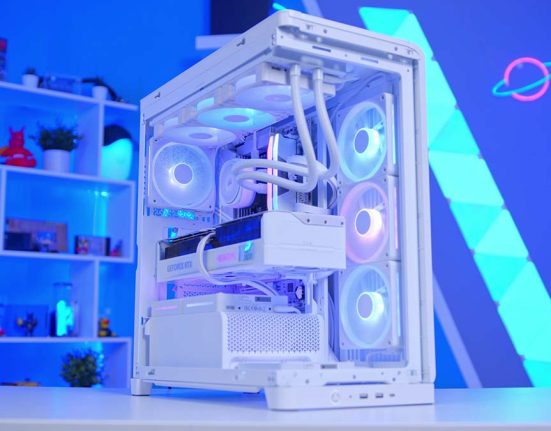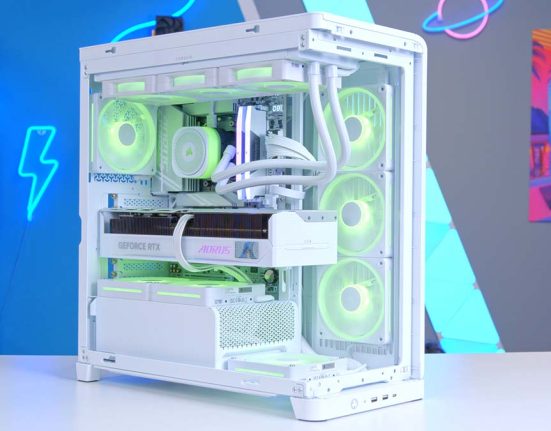The world’s first triple-chamber fish tank-style chassis, invented by Corsair, has hit the market. The Corsair AIR 5400 Case was first unveiled by Corsair at Computex in 2025, and it excited PC enthusiasts all over the technology scene. It features a dedicated CPU cooling area, a central chamber with an air duct to focus air flow for the GPU and motherboard, and a third chamber to keep your mass storage and power supply isolated and cooled away from the other areas.
In this review, we’ll tell you about all the cool and exciting features this case has to offer, share our experiences using it, discuss what we liked, and mention some potential forecasted setbacks. So, if you’re interested in what it has to offer and want to find out whether this is engineering brilliance or unnecessary overcomplication, join us.
Specification
The Corsair AIR 5400 case is a considerably wide Mid-tower case, measuring approximately 470mm in length, 340mm in width, and 467mm in height. Most mainstream motherboards for gaming and enthusiasts are covered, as this case supports a wide range of them.
In this case, we see Corsair taking a different approach to the typical front IO ports on a chassis; they’ve chosen to completely omit USB Type-A ports, leaving you with three USB Type-C ports offering speeds of up to 5GB/s for two and 20GB/s for one. There’s also a combined microphone and headphone jack, along with a power button to turn the PC on.
Whilst this case can house a radiator in three different locations (front, top, and bottom), it does have a specifically designed area for a radiator of up to 360mm on the front panel behind the bulk of the case visuals. The case also comes pre-installed with three 120mm fans, and you can choose which fans the chassis will have, depending on which model you opt for. These fans are mounted on the bottom panel.
In terms of storage, the chassis has capacity for up to two SSD drives and one HDD, nestled in the rear chamber behind the motherboard. Also in the rear chamber: there is enough space for a PSU with a length of up to 200mm.
| Specification | Corsair AIR 5400 (AIR 5400 RS-R & AIR 5400 LX-R ) |
|---|---|
| Form Factor | Mid-Tower |
| Motherboard Support | M-ITX | M-ATX | ATX | E-ATX | Reverse (305 x 277mm) |
| Case Dimensions (L x W x H) | 470 x 340 x 467 mm |
| Front IO | 2 x USB 3.2 Gen1 USB Type-C (5Gb/s) 1 x USB 3.2 Gen2 USB Type-C (20Gb/s) Combo Mic/Headphone Jack Power Button |
| PCI-E Slots | 7 x Horizontal |
| Colour Options | Black | White |
| Max Clearance | GPU Length: Up to 430mm PSU Length: Up to 200mm CPU Cooler Height: Up to 180mm |
| Drive Support | Up to 2 x 2.5 inch Up to 1 x 3.5 inch |
| Fan Support | Front: Up to 3 x 120mm Top: Up to 3 x 120mm Bottom: Up to 3 x 120mm Rear: 1 x 120mm |
| Radiator Support | Front: Up to 360mm Top: Up to 360mm Bottom: Up to 360mm Rear: None. PSU Shroud: None. |
| Pre-Installed Fans (Fan type is model dependent) | Front: None. Top: None. Bottom: 3 x 120mm PSU Shroud: None. Side: None. Rear: None. |
| MSRP AIR 5400 RS-R / AIR 5400 LX-R | $229.99 / $309.99 £239.99 / £284.99 |
Two case models will be available at launch, each offered in either black or white: the AIR 5400 RS-R and the AIR 5400 LX-R.
RS-R Variant
Ships with three RS120-R reverse-rotor fans pre-installed on the bottom panel. These PWM fans feature daisy-chain connections for reduced cable clutter and easier installation. While no RGB controller is included, both fan speed and lighting can be managed directly through the motherboard software. The MSRP for this variant is $229.99.
LX-R Variant
Includes three LX120-R reverse-rotor fans, pre-installed on the bottom panel, and a pre-installed iCUE LINK System Hub. The single-cable design streamlines routing, while the hub supports up to 24 devices, making expansion simple for even the most demanding setups. The MSRP for this variant is a bit more expensive at $309.99
Last but not least, this case comes in two colour ways, black and white, ensuring it fits in with any setup. That brings the total number of variants to four, as they combine the two colour options with the different lighting and fan configurations on offer.
Corsair AIR 5400 Design
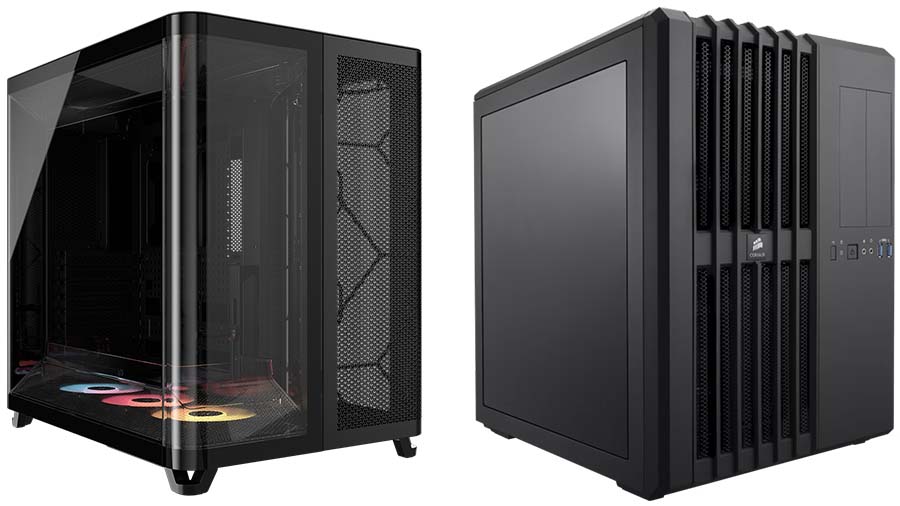
Corsair have designed this case as a homage to the Corsair AIR 540, released in 2013 and known for its superior airflow. We can see that the AIR 5400 shares the same design language for the external chassis as the AIR 540.
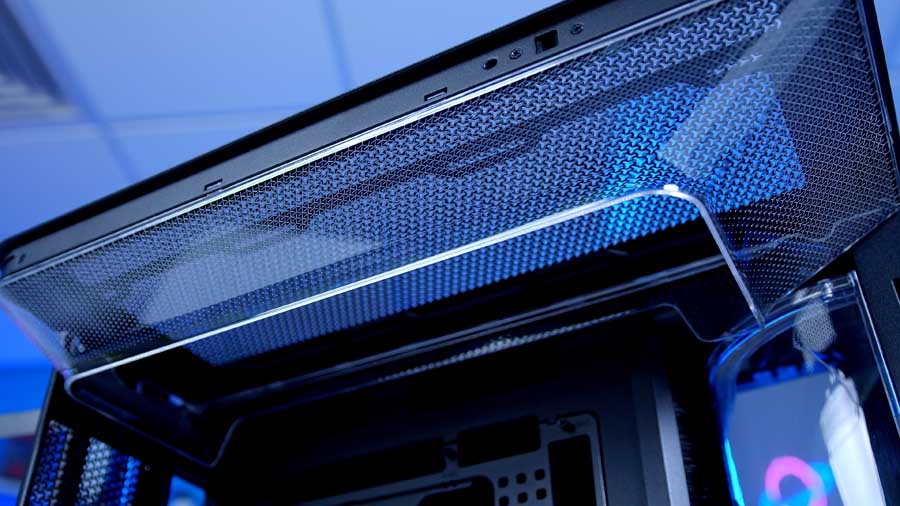
The AIR 5400 is a fish tank-style chassis with three chambers dedicated to cooling specific components. The first chamber is where all the magic happens. This is where your components, like your GPU, CPU, RAM and Motherboard, are mounted. The intake fans feature a dust filter followed by removable internal air ducts with strakes for feeding the air directly into the GPU and out of the top of the case via another air duct situated at the top of the case. So, as the hot air rises, it will naturally exit through the top.
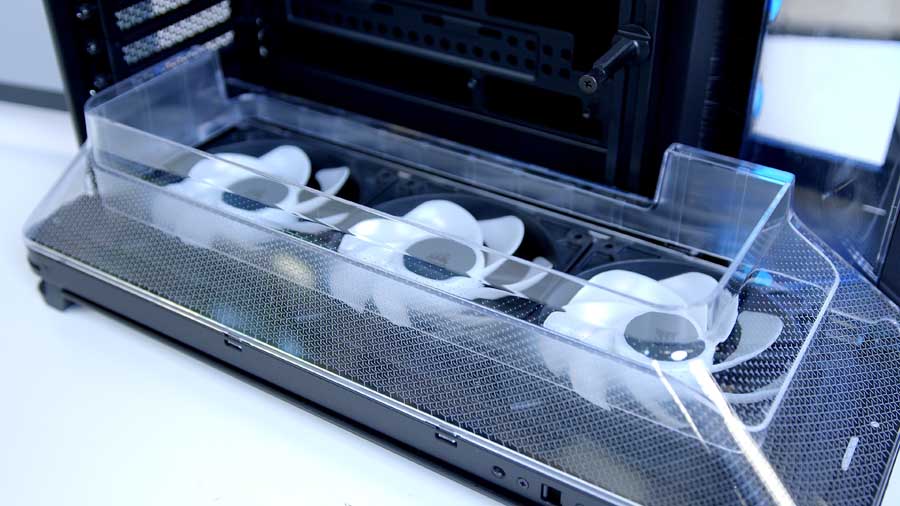
The second chamber is one we’ve seen before, an isolated chamber for the PSU and storage devices. On the back panel, there is a PSU cooling intake opening that allows the PSU to pull in air from the back.
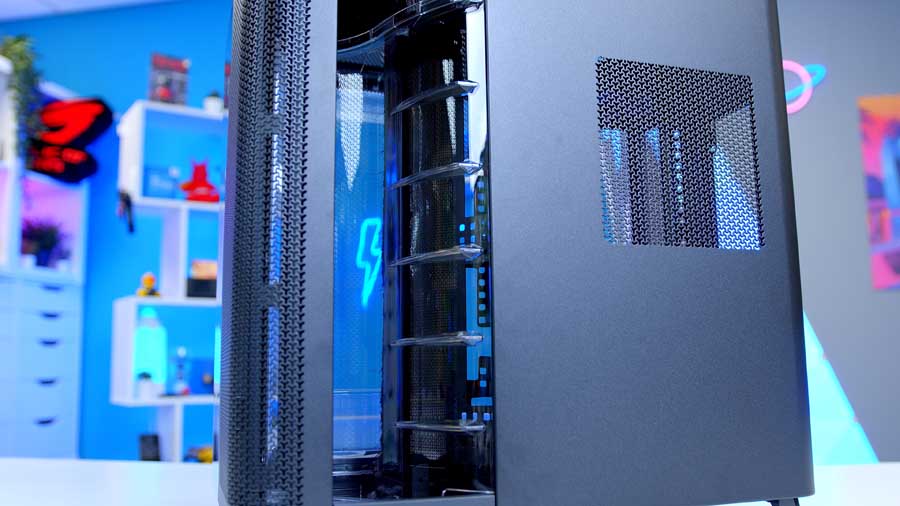
The most intriguing chamber is the third, specifically contrived to cool the CPU by separating the radiator and fan components of a CPU AIO cooler from the rest of the ecosystem. What makes this unique is that the heat from the CPU is exhausted directly out of the case through the distinguished exhaust opening. This ensures that no other components are affected by the heat produced, allowing your CPU to always get the coolest air possible. This is some awe-inspiring yet dubious engineering.
Corsair has replaced traditional rubber grommets with nylon brush interfaces between chambers. These not only block warm air from migrating between zones but also offer improved flexibility for cable routing. The brushes allow cables to pass through cleanly without the rigidity of fixed grommet holes, contributing to a sleeker internal aesthetic.
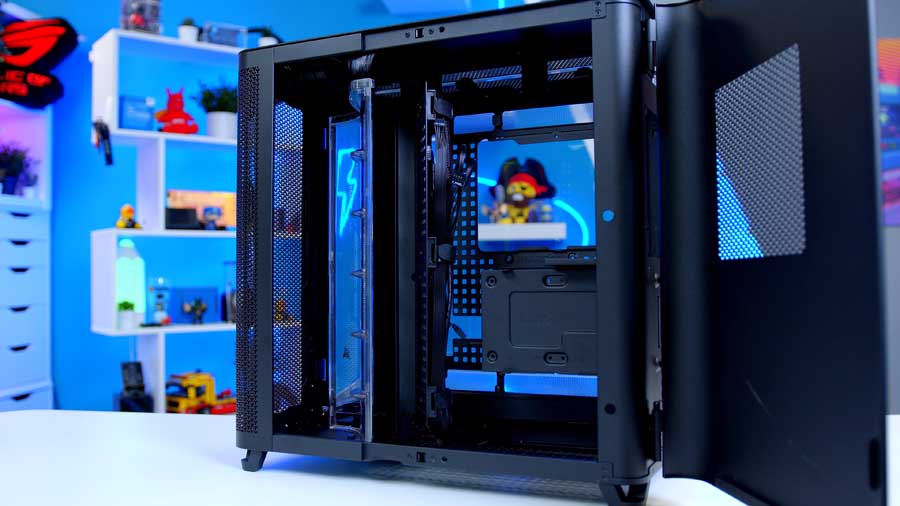
Complementing this is RapidRoute 2.0, Corsair’s second-generation cable management system. It features movable, modular ratcheting cable tie blocks that can be rotated and expanded laterally. This means you’re no longer constrained by fixed tie-down points, meaning that you can route cables exactly where you want them, with minimal obstruction and maximum control.
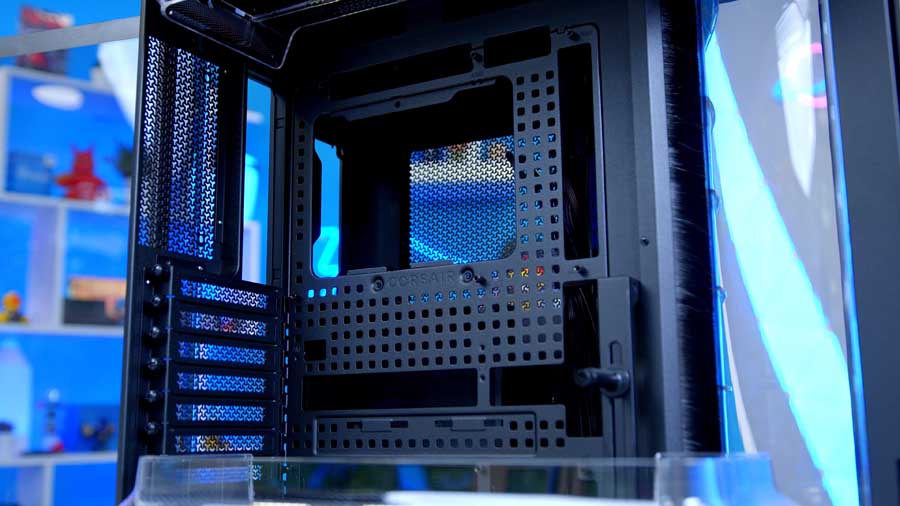
This case is built with the future in mind. As reverse motherboards become more popular due to their ability to make cable routing less of a hassle and help keep most of it hidden, case manufacturers are starting to incorporate more support for them within their chassis.
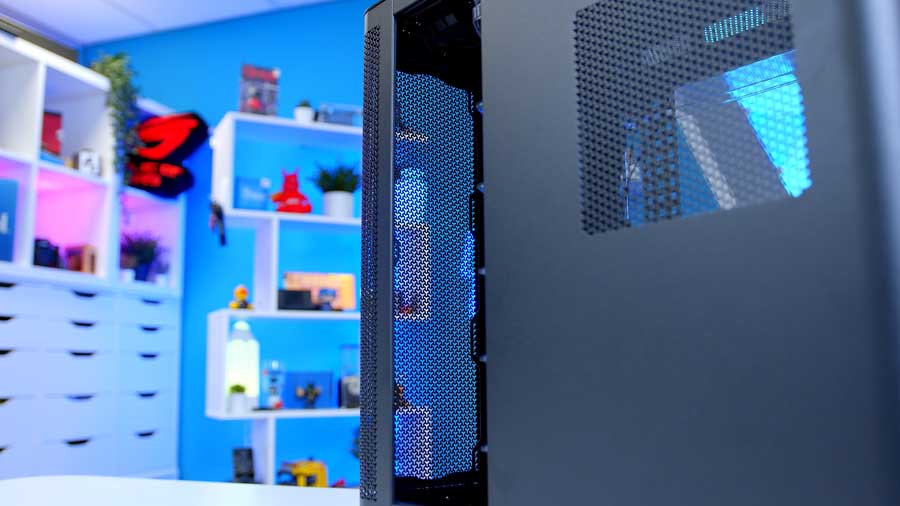
The chassis features ventilated steel panels that not only promote airflow but also reduce weight in key areas, balancing the overall heft of the case. Even so, it remains substantial at over 15kg with packaging and feels reassuringly solid. The side panels are tempered glass and open with a French door-style hinge mechanism, offering easy access and a premium feel. The front glass panel curves subtly, keeping the design modern and cohesive with the softened edges throughout.
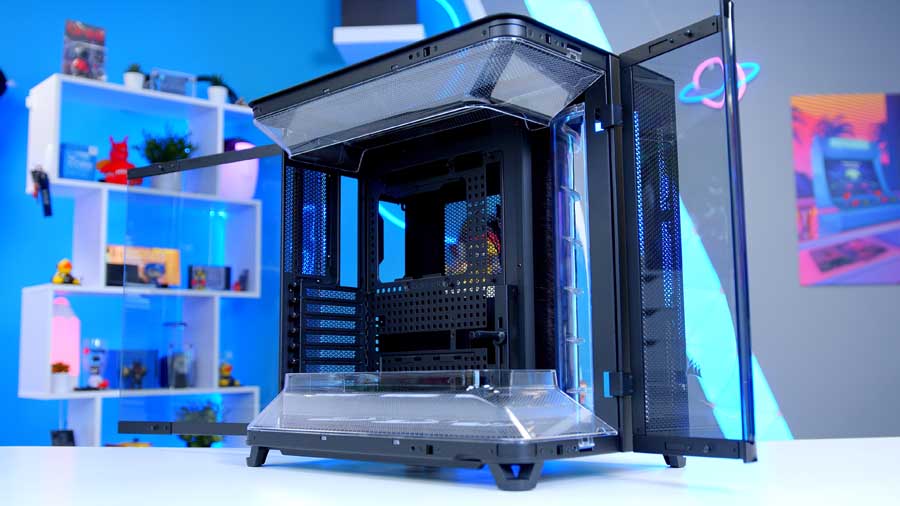
On the connectivity front, Corsair has opted for a minimalist approach: the front I/O panel is positioned along the top edge and includes three USB Type-C ports. While this is generous in terms of bandwidth, it may feel limited for users expecting a mix of legacy USB-A or audio jacks. Still, I feel that it aligns with the case’s future-forward-looking approach.
Features We Like
Genuine Fish tank
Plenty of cases get lumped into the “fish tank-style” category, but most of them still feel like conventional PC enclosures with oversized glass panels. The AIR 5400 is the first chassis we’ve seen that genuinely earns the label. It’s visual transparency, especially the small rear window that enables complete visibility, evokes the clarity and openness of an actual aquarium. It’s not just a case with glass; it’s a case that embodies the spirit of the fish tank form factor. You could almost imagine fish swimming through it. That’s not something we’ve ever said about a PC case before.
The Creative Engineering Drive
It’s always a risk to step out with a new idea; you never know how it’ll land or how consumers will respond. Corsair benefits from a strong, supportive fan base – a clear edge over much of the competition. Still, with an MSRP topping out around $310, this venture carves an experimental-sized hole in anyone’s wallet.
We’ve seen smaller brands take the first leap into creative territory, like with the ‘fish tank-style’ aesthetic, for instance, which is a direct evolution of HYTE’s Y60 case. It’s refreshing to see a major player like Corsair re-enter the unknown. Hopefully, this marks a genuine push toward inventive design and new cooling paradigms.
Features We Don’t Like
Nylon Brush Dividers
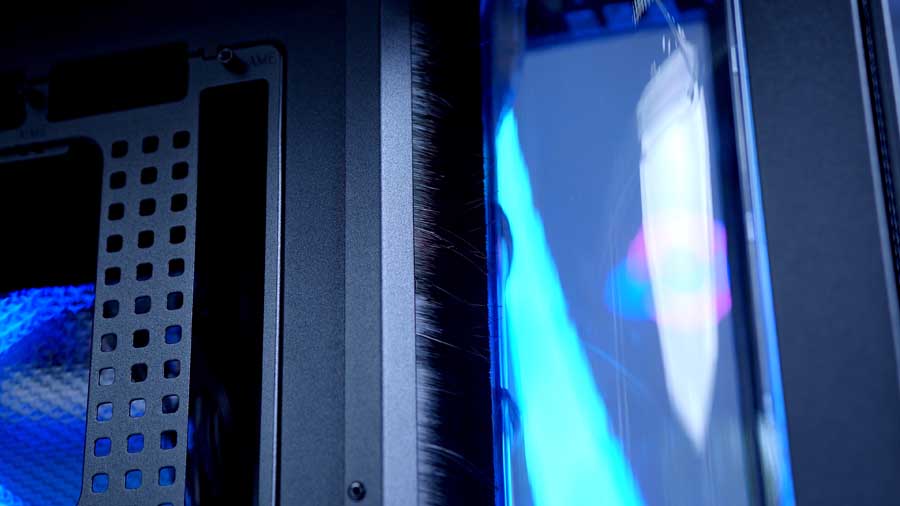
Nylon tends to cling to dust, and these dividers look a bit silly in practice, even if the intent is clear. Structurally, nylon is prone to warping and kinking over time, especially without reinforcement, so we’re already anticipating stray bristles or sagging sections. That said, it could be a step toward more inventive ways of concealing internal zones without resorting to rigid panels. We just hope future iterations refine both the material choice and the aesthetic execution.
Potential Dirt and Dust Magnet
The case includes just one dust filter fitted as standard, positioned at the bottom intake, with an optional filter for the front panel. With the radiator fans pulling in a high volume of air, the radiator risks becoming a dust magnet, should the optional filter go unnoticed. That said, configuring the front fans as exhaust should mitigate this issue by reversing airflow direction.
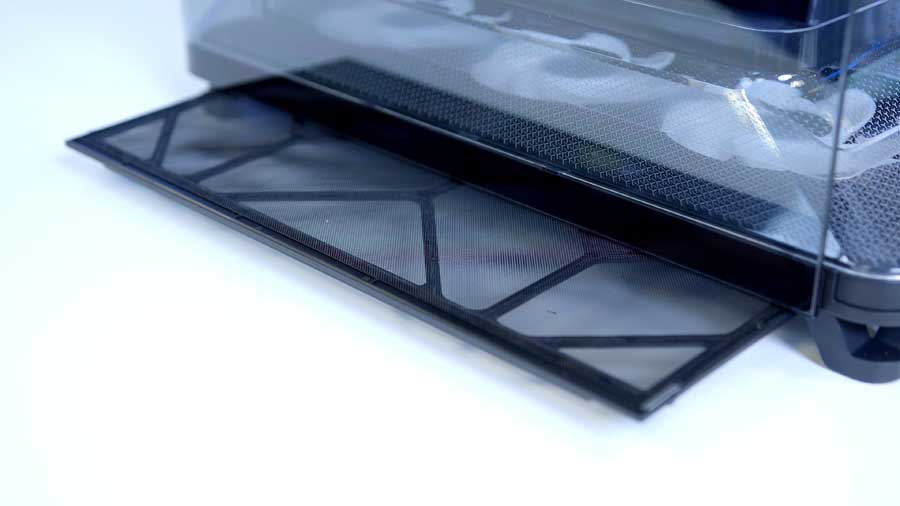
Cleaning is another concern. The glass panels pick up fingerprints easily, especially in the areas you naturally grip when handling the case. Combined with the unfiltered top panel and the exposed metal front section, keeping this build clean could be a real challenge.
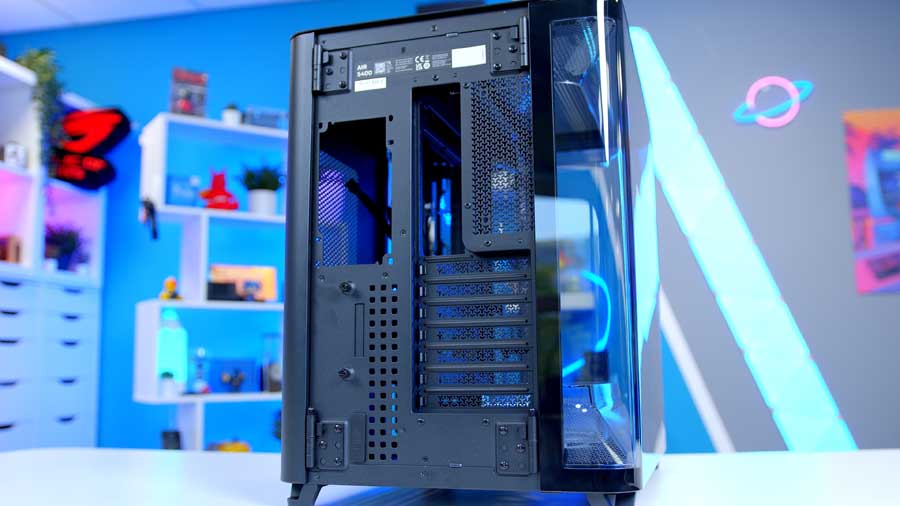
Accessories not labelled
At this price point, from a brand as established as Corsair, unlabeled accessories feel like a careless oversight. Clear labelling should be standard by now as it’s a basic courtesy to the user, mainly when the case includes multiple brackets, screws, or modular components. Skipping this step adds unnecessary discord to the build process and undermines the premium experience that Corsair is trying to sell. It’s hard to understand why user ease was deprioritised here.
Conclusion
Corsair AIR 5400 Case

Product Name: AIR 5400
Brand: Corsair
-
Features
-
Design
-
Versatility
-
Value For Money
Summary
It’s fair to say we weren’t entirely sold on the feature set here, and believe me, I was genuinely excited when I first unboxed it. The chassis market has felt stagnant for years, and while this is still a ‘fish tank’ style case at heart, it gestures toward something more. Corsair’s design hints at a willingness to rethink the formula, and that alone deserves recognition.
The pricing, USB layout, reverse motherboard support, and the bold third chamber concept form a compelling foundation for an enthusiast-grade case. But innovation without validation is a gamble. Corsair’s decision to market a new thermal layout without publishing supporting data leaves us questioning its real-world impact. Still, I have to applaud Corsair for taking the leap. It is a risk to push new ideas into a space that often resists change. If this case sparks a wave of creative rethinks in airflow and internal segmentation, then it may be a step in the right direction.
Pros
✅ Ingenious design
✅ Sleek and premium build
✅ Easy to access
Cons
❌ Quite expensive
❌ Lack of official test data
❌ Needs more refinement


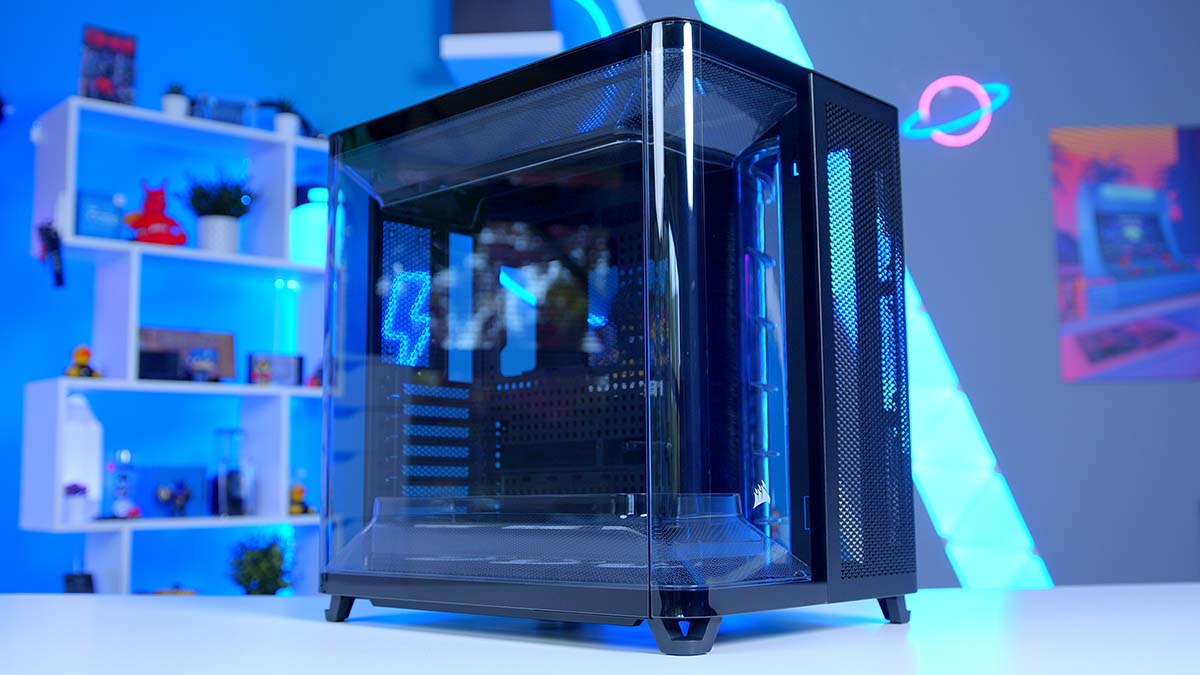
![FI_[DM78] Corsair Air 5400 + 5090 Gaming PC Build](https://geekawhat.com/wp-content/uploads/2025/11/FI_DM78-Corsair-Air-5400-5090-Gaming-PC-Build-551x431.jpg)
![FI_[DP051] Antec C5 + 5070Ti Gaming PC Build](https://geekawhat.com/wp-content/uploads/2025/11/FI_DP051-Antec-C5-5070Ti-Gaming-PC-Build-551x431.jpg)
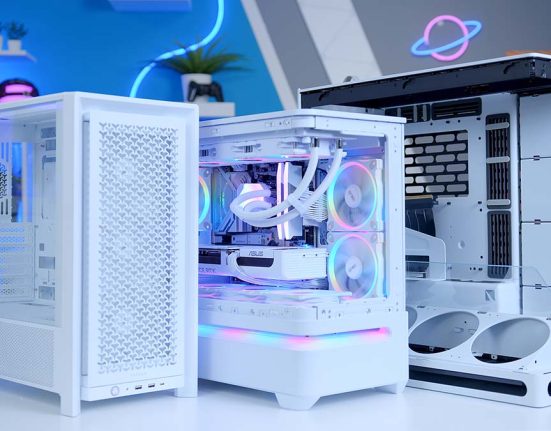
![FI_[DM76] HAVN BF360 5090 Build](https://geekawhat.com/wp-content/uploads/2025/10/FI_DM76-HAVN-BF360-5090-Build-1-551x431.jpg)
